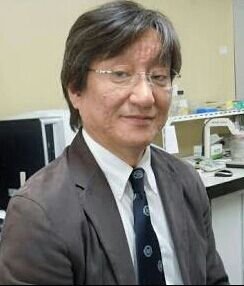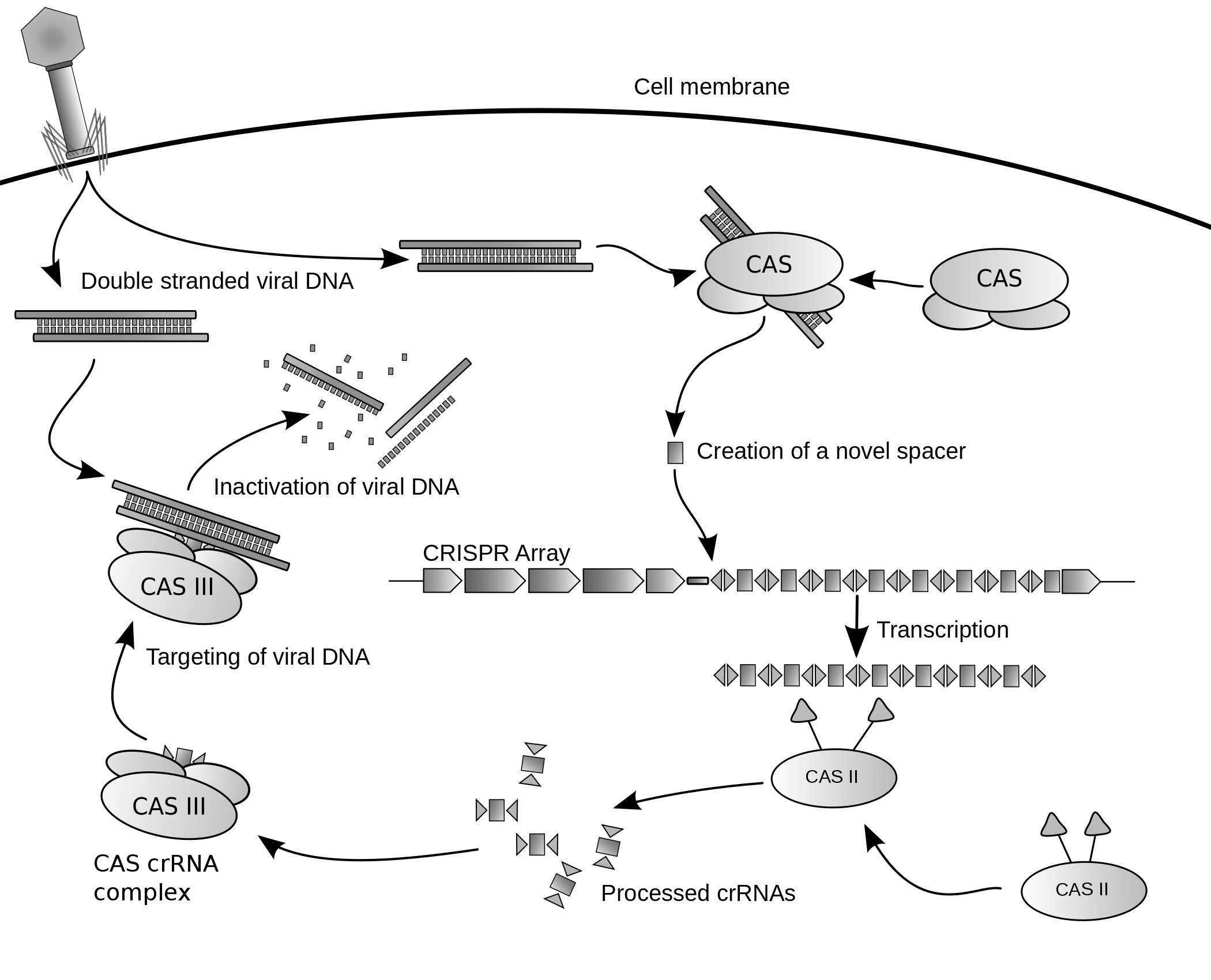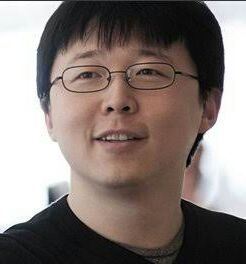.jpeg)
From the very beginning of the human history we have tried cracking the enigma of life, to tame it for our whims and needs. First came a wave of domestication followed by selective breeding, always supported by nature's own selection.The watershed moment came when Mendel discovered the pattern of inheritence: a 'hint at the genetic basis of life'. Soon nucleic acids(DNA, RNA) were found to be the conduits of this pattern of inheritance followed by the insight into their structure and the detailed dynamics of molecular biology. Since then we have tried cracking this code in the ultimate quest of 'playing god'. In 1950's, with the discovery of restriction endonuclease and development of recombinant DNA technology came the dawn of the science of genetic engineering. In recent times, a novel technique by the name of CRISPR-Cas System has come to the scene.The technique has brought us to the cusp of the next big revolution in genetic engineering at our doorstep.It literally has the potential to change the face of humanity forever.
So let's talk about it.
The story of CRISPR-Cas system
In the year 1987, while sequencing the genome of E. Coli for studying Iap genes Japanese Scientist Yoshizumi Ishine and his colleagues noticed an unusual sequence of DNA. Near the gene under study , they found identical but palindromic DNA repeats seperated from each other by seemingly random and unique sequences they called SPACERS. Later many scientists too found similar patterns in many other microbial genomes.They called this unusual repeats of seemingly junk DNA as CRISPR for 'Clustered Regularly Interspaced Short Palindromic Repeats' (indeed a Crispy acronym).
On futher studies, another loci of gene invariably located very close to the CRISPR gene loci encoding DNA endonuclease were found and were named CRISPR associated genes(Cas).
A group of scientists in the year 2005 reported that the random peice of spacer gene were instead similar to and matched many viral genomes and plasmids
The seemingly disparate pieces of then thought off junk DNA remained a mystery for sometime. But due to a community effort of various scientists like Jennifer Doudna , Eugene Konnin, Mojica , Feng Zhang, Carpentier this was about to change.

Yoshizumi Ishino
The Working of CRISPR-Cas System
On solving the jigsaw puzzle from various bit and pieces of research done by many scientists on various aspects of this system its functioning becomes clear.The system in mocrobes invariably works as a counterattacking weapon against viral attacks.
When a virus invades a microbe, the host cell grabs a piece of the invading viral genome and puts it into its own DNA as a unique barcode of that virus in a repository of SPACERS mentioned earlier. The microbes then copies the spacer into an RNA molecule called CRISPR RNA ( cr-rna).The Cas enzyme then binds to the specific cr-rna with the help of a guide-rna. This active complex then wander around the cell and if it finds any viral genetic material complementary to the cr-rna ,it binds to it and by the endonuclease property of Cas enzyme induce a double stranded break in that viral DNA hence neutralising it.
Hence the system can be compared to "a GUIDED missile system" where the cr-rna acts as a GPS system guiding the missile ie. Cas enzyme to neutralise the target like viruses/plasmids/phages.
The CRISPR-Cas system is a veritable dictionary of various virus that had invaded the virus: a 'DNA archive of previous infection'.
This system by the virtue of its function can be compared to an aquired immune system for microbes where the CRISPR acts as a 'vaccination card' and Cas as the 'effector of immunity'.
.png)
The working of the CRISPR-Cas system in microbes
Eureka Moment
A major breakthrough came when Siksnys and his colleagues showed that the system from microbes can be reprogrammed to target a site of their choosing in a wide range of life forms by changing the sequence of the cr-rna. Jennifer Doudna and her colleagues reengineered the system into a more manageable two-component system of a Cas molecule and a single-guide rna(sg-rna: by combining the cr-rna and tracr-rna).This greatly increased the ease to handle the system. Hence, harnessing the above breakthroughs the system can now be used as a 'Genome Editing Tool'(precisely, a 'word processor of our genome)

Jennifer Doudna

Feng Zhang
Harnessing the technology for gene editing
In this novel technique, first, the DNA segment that has to be knocked/replaced/inserted is identified.Then an RNA sequence complementary to the targert DNA sequence is synthesized.This RNA is then attached to the Cas enzyme hence reprogramming it to target the DNA sequence we are interested in.The whole complex is then delivered into the host cell.
THE RNA molecule guides the Cas enzyme to the target DNA sequence .Once the sequence is recognised the Cas enzyme cleavess the DNA inducing double strand breaks.
The DNA break induces the repair mechanisms of the host cell. The broken ends are joined together by Non Homology End Joining repair process (NHEJ) which is an error prone process leading to a small deletion or addition of sequence that forms gene sequence that isn't correct enough to regain its function and hence the target gene would be rendered ineffective.
If a DNA sequence is to be added, the same DNA sequence is inserted along with the CRISPR-Cas system. After the system breaks the host genome at intended site the target DNA gets incorporated into the site by Homology-directed Recombination repair.(HR).
.png)
Use of crispr cas 9 in gene edition
WHY CRISPR?
Previous techniques were exorbitantly expensive, required special laboratory settings, were inefficient, cumbersome, took a long time to furnish results, and were not precise enough. The CRISPR-Cas system has answers to these limitations.
Previous gene editing tools were very inefficient for eg. Every time a new gene had to be targeted, a whole new set of panels had to be designed whereas the CRISPR-Cas system can target many gene loci in a single go. This can be explained by an analogy that 'what if you had to rewire the whole computer for a single software change v/s downloading a needed software and deleting the one you didnt want without actually changing the hardware'.
Hence the CRISPR-Cas system provides a faster, cheaper, accesible, precise and versatile gene editing alternative.This system also opens new avenues which wouldn't have been thought off with existing technologies.
Applications

From the very beginning of the understanding of its functioning, many smart scientists have speculated the game changing application it could have. The speculation were firmed when recent news of Chinese scientist like Fheng Zang, George Church and colleagues getting success in gene editing the human embryos started to get viral.The power to edit ones genome has immense application. Some of which are discussed below
Death of the diseases
Around 7-9 million children are born each year with some genetic birth defects like sickle cell anaemia, β thalassemias etc. This mutations can be safely altered to normalcy at germ cell stage to eliminate many genetic diseases.
In recents experiments HIV virus incorporated into infected host cells in dormantt stages (a major challenge to a definitive cure of AIDS) was cut off from the host DNA and destroyed with the CRISPR-Cas system.
Many gene defects responsible for metabolic diseases like diabetes and mucopolysaccharidosis etc. too can be targeted.
Deletion of ageing related genes and activation of antiagening one can empower humans to control ageing.
Understanding gene functions
Using gene edition we can delete or insert various genes into a target model and see for alteration the step has caused. This could help us better understand the functions and dynamics of many gene whose functions remains unknown presently.This could also help us better understand the pathophysiology and etiology of various diseases.
Biomedicine
The technology can be used to target virulence factors, microbial genes encoding for antimicrobial resistance and other relevant factors of a causative organism. Hence the doors are open now for this system to be used as a novel antibiotic therapy way different from the conventional ones.
Gene Drive
The abilities of the CRISPR can be harnessed to create "selfish genes". This genes make sure that they get inherited to the progeny always under any circumstances. This characteristic can be used to tackle many problems.for Eg. To curb the menace of malaria. Researchers have experimented with inserting a selfish gene that impart plasmodium-resistance to the mosquitoes. When this engineered mosquitoes would be introduced into natural population, after certain breeding cycles, majority of the mosquitoes will be plasmodium infection resistant and hence now malaria could not be transferded from an infected to a healthy person by the virtue of these resistant mosquitoes .Hence bringing a halt to the spread and an eventual elimination of malaria.
Genetic engineering
The system provides us with the power to edit genome at various levels including DNA, RNA and even epigentic level.Hence we could be enjoying the power of edit our genome at the whims of our needs in near future.
This may be a dawn of an era where "DESIGNER BABIES " may be a real hing.
%20(1).jpg)
LIMITATIONS AND ETHICAL CONSIDERATIONS
Not all are jovial about this powerful and potentially game changing tool. There are many who are a bit sceptical about the use(or as they say: "abuse") of this technology.
Some bring the ghost of "eugenics" to defend their arguments. But isn't it already prevailing in current societies. What do you than think about IVF and better diagnostic technologies that have helped us weed out fetuses with potential risk of down syndrome in utero and termination of such pregnancies (around 70% of all such pregnancies are terminated in developed countries). What do they have to say about prevalent practices of selective breeding for superior qulities of progeny and even plastic surgeries are an example to this. Instead we should be using the CRISPR-Cas system to improve present ART technologies so that the defective embryos can be edited off many such diseases.
Some brush off this technology as too far fetched and just another science fiction hoax. This is similar to a person saying 'computers' in 1970s and how it would become an integral and indespensable part of human life. It was deemed then as a science fiction and sometimes even fear-mongered upon. But in true sense we saw science fiction become our reality in all these years. The developments in genetic engineering is at one such phase.
There are many genuine shortcomings and potential fallouts of this powerful technology like :
- Unwarranted, unintended and unpredictable functions of genes which may be exposed only when the gene are added or deleted.
- Abuse by unscrupulous entities for bioterrorism (eg super soldiers , super bugs etc)
- Formation of designer babies and following wave of classist sentiments of "being modified vs not"
- Being a cheap, easy to use, efficient gene editing tool essentially democratise its use and hence increases the chance of its misuse
What next?
There is a lot more to gain from an advance of such magnitude then to be apprehensive about it. Developing cold feet to this would essentially mean going down the path of what happened to the "Advances in Nuclear Energy". We should start a global conversation on how to harness the intended positive impacts, overcome the existing limitation and prevent the unintended consequences.
Not embracing the technology would be a grave mistake which will lead the technology to wander off to domains we are uncomfortable dealing with.Instead participation can ensure that future research about the advancements in this technology are guided by caution, reason, oversight and transperancy.
Whether you embrace it or not, whatever you may think of it, the future of CRISPR-Cas technology is approaching us fast enough to be avoided.The so called science fiction will soon be our reality.
To simply put my point, start 'playing god' or you would act 'puppets' to the one who take the plunge in this so called Shakespearean "Stage of Life".
KAVIN BHOGAR
Medical Student
VMMC & Safdarjung Hospital
DONATE :)
BTC
124Ca7VeVyBuvM4BJtym6twjabmgiS9ZZM
ETH
0x0d94c708bfb4f44d2734ea38ef5a5d3a5010a267
LTC
LbKZxctdfX5oDV23SCsPuFPpk1ohfz5dYF
ow nice..I share it..
nice article..
Downvoting a post can decrease pending rewards and make it less visible. Common reasons:
Submit
Thank you.....do encourage others to read it too. Thank you again😊.....and yes do share it
Downvoting a post can decrease pending rewards and make it less visible. Common reasons:
Submit